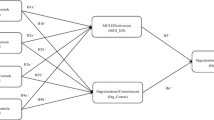Abstract
A key concern in implementing organizational controls is that little is known about when controls lead to “negative” employee responses. Previous research has suggested that lower levels of negative responses will be observed only if the controls that are being employed “fit” the characteristics of the tasks being controlled. The two task characteristics usually referred to include performance (outcome) documentation and procedural (cause-effect) knowledge. Unlike previous studies, however, this study assumes that the two task characteristics should have a joint, rather than independent, influence on employee responses to controls. The reason is that knowledge of how well one is doing is not sufficient for expecting lower levels of negative responses if information on procedures that may lead to better performance is not available. Knowledge of procedures, likewise, is not sufficient for lower levels of negative responses if performance documentation is not available. Results of an empirical study provide general support for the above line of reasoning.
Similar content being viewed by others
References
Argyris, Chris. 1953. “Human Problems With Budgets.”Harvard Business Review 31 (January/February): 97–110.
Armstrong, J. Scott and Terry Overton. 1977. “Estimating Non-Response Bias in Mail Surveys.”Journal of Marketing Research 14 (August): 396–402.
Bandura, Albert and Daniel Cervone. 1983. “Self-Evaluative and Self Efficacy Mechanisms Governing the Motivational Effects of Goal Systems.”Journal of Personality and Social Psychology 45 (November): 1017–1028.
Birnberg, Jacob G., Lawrence Turopolec, and S. Mark Young. 1983. “The Organizational Context of Accounting.”Accounting, Organizations, and Society 8 (2/3): 111–129.
Blalock, Hubert M. 1979.Social Statistics. New York: McGraw-Hill.
Chow, Gregory C. 1960. “Test of Equality Between Sets of Coefficients in Two Linear Regressions.”Econometrika 28 (July): 591–605.
Collins, Barry E. and Harold S. Guetzkow. 1964.A Social Psychology of Group Processes for Decision-Making. New York: John Wiley and Sons.
Cooper, Lee G. and Masao Nakanishi. 1983. “Standardizing Variables in Multiplicative Choice Models.”Journal of Consumer Research 10 (June): 96–108.
Flamholtz, Eric G., T.K. Das, and Anne S. Tsui. 1985. “Toward an Integrative Framework of Organizational Control.”Accounting, Organizations, and Society 10 (1): 35–50.
Frederiksen, Lee W. 1982.Handbook of Organizational Behavior Management. New York: John Wiley and Sons.
Hirst, Mark K. 1981. “Accounting Information and the Evaluation of Subordinate Performance: A Situational Approach.”Accounting Review 56 (October): 771–784.
————— 1983. “Reliance on Accounting Performance Measures, Task Uncertainty, and Dysfunctional Behavior: Some Extensions.”Journal of Accounting Research 21 (Autumn): 596–605.
Jaworski, Bernard J. 1988. “Toward a Theory of Marketing Control: Environmental Context, Control Types, and Consequences.”Journal of Marketing 52 (July): 23–39.
Jaworski, Bernard J. and Deborah J. MacInnis. 1989. “Marketing Jobs and Management Controls: Toward a Framework.”Journal of Marketing Research 26 (November): 406–419.
Karasek, Robert A., Jr. 1979. “Job Demands, Job Decision Latitude, and Mental Strain: Implications for Job Redesign.”Administrative Science Quarterly 24 (June): 285–308.
Kerr, Steven. 1990. “Substitutes for Leadership: Some Implications for Organizational Design.” InOrganizational Behavior and Management. Ed. Henry L. Tosi. Boston. MA: PWS-Kent Publishing, pp. 507–517.
Luthans, Fred. 1977.Organizational Behavior. New York: McGraw-Hill.
Merchant, Kenneth. 1982. “On the Incidence and Causes of Dysfunctional Side Effects of Control Systems.” Unpublished paper presented at the American Accounting Association Annual Meeting, Reno, NV.
Neter, John, William Wasserman, and Michael H. Kutner. 1985.Applied Linear Statistical Models: Regression, Analysis of Variance, and Experimental Designs. Second Edition. Homewood, IL: Richard D. Irwin.
Nunnally, Jum C. 1978.Psychometric Theory. New York: McGraw-Hill.
Ouchi, William G. 1979. “A Conceptual Framework for the Design of Organizational Control Mechanisms.”Management Science 25 (September): 833–847.
Ouchi, William G. and Margaret A. Maguire. 1975. “Organizational Control: Two Functions.”Administrative Science Quarterly 20 (December): 559–569.
Porter, Lyman W., Edward E. Lawler III, and Richard J. Hackman. 1975.Behavior in Organizations. New York: McGraw-Hill.
Rockness, Howard O. and Michael D. Shields. 1984. “Organizational Control Systems in Research and Development.”Accounting, Organizations, and Society 9 (2): 165–177.
Sackett, Paul R., Michael M. Harris, and John M. Orr. 1986. “On Seeking Moderator Variables in Meta-Analysis of Correlational Data: A Monte Carlo Simulation Investigation of Statistical Power and Resistance to Type I Error.”Journal of Applied Psychology 71 (May): 302–310.
Sarbin, Theodore R. and Vernon L. Allen. 1968. “Increasing Participation in a Natural Group Setting: A Preliminary Report.”The Psychological Record 18 (January): 1–7.
Thompson, James D. 1967.Organizations in Action. New York: McGraw-Hill.
Turcotte, William E. 1974. “Control Systems, Performance, and Satisfaction in Two State Agencies.”Administrative Science Quarterly 19 (March): 60–73.
Author information
Authors and Affiliations
Additional information
He obtained his Ph.D. at the Ohio State University. His research interests include the areas of international marketing and sales management. He has previously published inAdvances in International Marketing, International Trade Journal, Journal of the Academy of Marketing Science, Journal of International Business Studies, Journal of Personal Selling and Sales Management, and contributed to several national and international conference proceedings.
He obtained his Ph.D. at the University of Texas at Austin. His research interests include sales management, marketing strategy, and international marketing. He has previously published inInternational Journal of Research in Marketing, International Trade Journal, Journal of Economic Behavior and Organization, Journal of the Academy of Marketing Science, Journal of International Business Studies, Journal of Personal Selling and Sales Management, Technology Forecasting and Social Change, and contributed to numerous conference proceedings.
Rights and permissions
About this article
Cite this article
Agarwal, S., Ramaswami, S.N. Marketing controls and employee responses: The moderating role of task characteristics. JAMS 21, 293–306 (1993). https://doi.org/10.1007/BF02894522
Issue Date:
DOI: https://doi.org/10.1007/BF02894522




